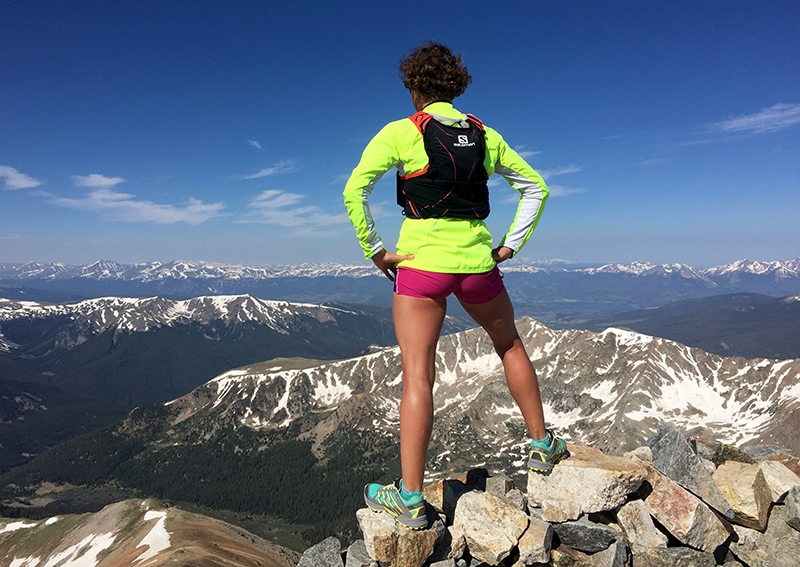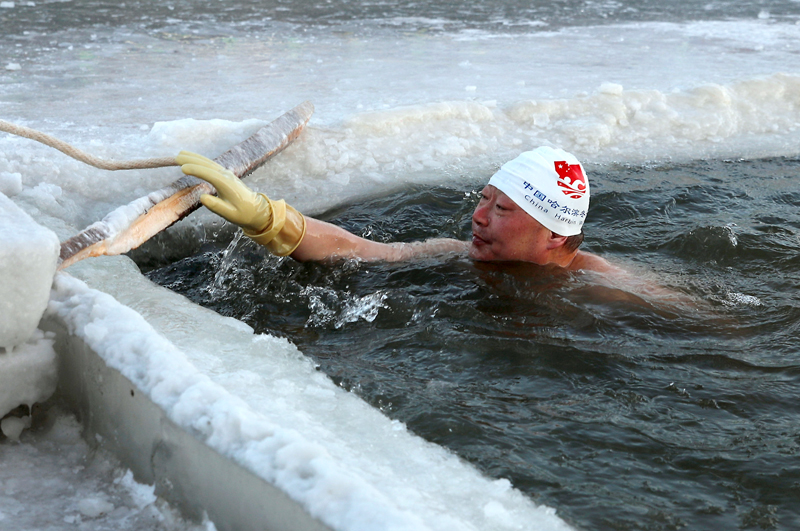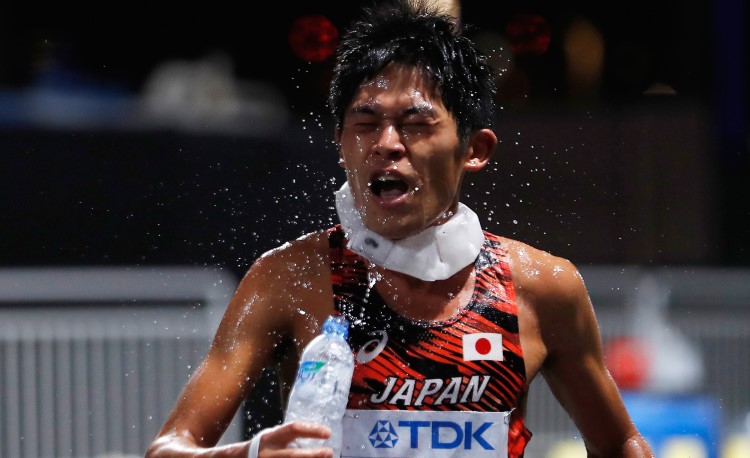You are viewing 1 of your 1 free articles. For unlimited access take a risk-free trial
Altitude training: can it help endurance athletes reach new heights?
Pre-competition altitude training has long been used as strategy to enhance performance in endurance athletes. But how much does altitude training really help and can athletes reap the same benefits from simulated altitude training? Belle Roels and Grégoire Millet look at the latest evidence
The popular belief that altitude training enhances endurance has probably arisen from the success of a number of middle to long-distance runners who have resided at altitude(1). Meanwhile, the scientific theory for using altitude training has long been based on the assumption that the aerobic performance may be enhanced as a consequence of increases in red blood cell count (RBC) or erythrocytes, serum erythropoietin (EPO), and haemoglobin (Hb) concentration, which enhance oxygen-carrying capacity and maximal oxygen uptake capacity (VO2max) of an athlete training at altitude, allowing them to train and perform better upon return to sea level or to lower altitude(2, 3).However, this improvement in performance could also be explained by other mechanisms involving muscular, hormonal or respiratory parameters as improvement in locomotion economy, muscle buffering capacity, or ventilatory efficiency. Indeed, the expert scientists in the field have recently been debating whether or not the benefits of altitude training are mediated primarily by an increased RBC (4).
Physiological adaptations to altitude
Altitude induces hypoxia (an inadequate supply of oxygen to body tissues) and arises as a result of a reduction in the inspired oxygen pressure (PiO2). PiO2 decreases with increasing altitude; at sea level PiO2 is 149mmHg, but PIO2 is only about 50mmHg on the top of the Mount Everest – ie each lungful of air contains only around a third of the oxygen compared to sea level.
An altitude-induced PiO2 reduction, consequently leads to less oxygen available at the alveolar level in the lungs (PaO2), which in turn leads to less oxygen in the arterial blood (PaO2).
The altitude-induced decrease in PaO2 also induces a reduction in and kidney oxygenation (5). This reduction in kidney oxygenation is responsible for the stimulation of the production and the release of the hormone erythropoietin (EPO)(6). EPO stimulates red blood cell synthesis in the red bone marrow (7), which induces an increase in blood haemoglobin concentration. Higher haemoglobin concentrations increase the oxygen carrying capacity of the blood, which can therefore help restore endurance performance.
Another effect of altitude-induced decrease in PaO2 is an increase in pulmonary ventilation (Ve). This hyperventilation acts to partly offset the effects of altitude on PaO2 by helping to restore normal O2 delivery to tissues(8).
Altitude training induces changes in muscle tissue by increasing the myoglobin levels in muscle(9,10,11) and exposure to altitude also seems to increase muscle buffering capacity – ie the capacity to buffer the lactate that builds up in the muscle during and after exercise. This means that the muscle is capable of continuing to contract despite higher levels of muscular lactate concentration and without fatiguing to the same extent(12). More information on altitude-induced adaptations can be found in Wilber 2004(13).
Altitude training methods
Over the last few decades, several altitude training strategies have been used to enhance performance at sea level. These include the traditional altitude sojourn (living high/training high – LHTH), the living high/training low (LHTL) approach, and intermittent hypoxic exposure/training (IHE)/
(IHT) methods using artificial altitude simulation devices.
Living high-training high (LHTH)
Traditionally, athletes have lived and trained at moderate altitude (1,800-2,500m) for several weeks at a time, two to three times a year (13). However, although the athlete can focus solely on training, these LHTH camps demand a lot of time, money and sacrifices, such as leaving the home, job and family. There are a number of altitude training sites around the world at different levels of altitude.
These LHTH camps consist of several progressive phases (13):
- Acclimatisation – starts immediately on arrival at altitude. During this phase the athlete will acclimatise to the reduced PiO2 and must be aware not to overdo exhaustive training and/or activities and to take more recovery time between workouts compared to sea level. The duration of this phase ranges from 3-10 days, depending on the total duration of the LHTH camp and the training frequency;
- Primary training – lasts between 1-3 weeks but can be longer depending on the athlete’s goals. The purpose is to progressively increase the training volume to obtain similar sea-level training volumes and training intensity;
- Recovery – can last 2-5 days and is designed to prepare for the return to sea level and to recover completely from the complementary altitude-induced fatigue. The training volume and intensity is gradually reduced.
- A positive phase observed during the first 1-4 days (but not in all athletes), which might be due to the haemodilution, and ventilatory adaptations, which increase the oxygen carrying capacity;
- A phase of progressive reestablishment of sea-level training volume and intensity, during which the probability of good performance is reduced. This might be due to the altered energy costs and neuromuscular loss of adaptations while training at altitude, which will be improved again after several days of sea-level training;
- A fitness peak 15-20 days after return to sea level; the optimal time for competition is during this phase. A combination of positive factors (increased oxygen transport; improved economy and maintenance of ventilatory adaptations) explain the better performance during this third phase(17).
Living high-training low (LHTL)
This strategy attempts to maintain training intensity, but to evoke the beneficial effects of altitude, by living at moderate altitude but training at sea level or closer to sea level (18). A slightly different approach involves living at moderate altitude and performing low intensity training at moderate altitude, whereas the high intensity training is performed at sea level or lower altitudes (19).
The repeated descents from and ascents to altitude in LHTL, however, is stressful for athletes, not to mention the time wasted by travelling to and from the training sites, adaptation to the weather changes between altitude and sea level, increased fatigue due to the travel, the financial costs, etc. Moreover, only few places around the world can accommodate this LHTL method and consequently researchers have developed a variety of techniques to either simulate living high or training high for athletes at sea level (or simulate training low for athletes living at altitude), such as hypoxic tents and hypoxic rooms, hypoxic chambers (hypobaric hypoxia). These devices and tents are now available for all athletes and clubs to purchase. Currently, the LHTL method is recognised as a valuable method providing some extra-benefits (0.5-1.5%) when compared to similar sea-level training(20) although the underlying mechanisms remain unclear (21, 22).
Intermittent hypoxic exposure and training (IHE)
IHE or periodic exposure to hypoxia is defined as an exposure to hypoxia lasting from seconds to up to 8 hours, which is repeated over several days to weeks. These intermittent hypoxic bouts are separated by a return to normal oxygen conditions (normoxia). IHE can be combined with hypoxic training sessions to produce intermittent hypoxic training (IHT).
Several variations of IHT are possible, by varying the length of hypoxic exposure (seconds to hours), the number of hypoxic exposures a day, the number of consecutive days of exposure and the level of hypoxic stimulus (low, moderate, high altitude). Since only relative short periods of hypoxic stimulus are needed to stimulate EPO production (23, 24), the consensus is that IHE and IHT are sufficient to induce significant increases in EPO and RBC and to consequently improve the endurance performance and VO2max without all the negative effects of prolonged continual hypoxic exposure, such as fatigue, depression of the immune system and loss of muscle mass.
The most commonly used IHE protocol consists of 5 minutes of hypoxic exposure followed by 5 minutes of normal breathing for a total of 60-90 minutes a day. This is continued for three weeks on 5 consecutive days of each week (25). This strategy can allow a large number of athletes to experience simulated high altitude and individualised hypoxic exposure with minimal inconvenience.
To perform IHE or IHT, the same methods and devices used for the LHTL method can be used. However, due to the short durations of exposure and the need for quick changes between hypoxia and normoxia, new devices to help facilitate IHE and IHT have been developed, such as Hypoxicator, Go2Altitude, AltiPower, AltO2Lab, and Altitrainer 200. All these devices are based on nitrogen-dilution of normal air, oxygen extraction from air or re-breathing techniques, and all deliver lower oxygen concentrations at normal atmospheric pressure.
Practical applications
The scientific literature provides evidence that the LHTL method induces the clearest and most reliable performance enhancements compared to the traditional altitude training camps and the IHE/IHT method. LHTL appears to improve sea level performance by stimulating red blood cell production and oxygen transport capacity without the negative effects of muscle mass loss that can occur in athletes who perform all their training at altitude. However, the duration of the altitude stay and the level of altitude to live and train at are very important factors in this strategy.
In general, studies suggest that a stay of four weeks at altitude is necessary to obtain the altitude-induced benefits(3,19,26). As for actual altitudes in a LHTL strategy, athletes need to live high enough to benefit from the altitude-induced responses, yet train low enough to maintain high intensity training and offset the negative altitude-induced responses. It seems that living below 2,100m might not be sufficient enough to stimulate EPO and RBC production, whereas altitudes above 2,500m might induce training and recovery problems (27, 28).
To summarise, it appears that all of these hypoxic methods can induce favourable adaptations and the optimal preparation for a sea-level performance will probably be a combination of these methods. However, the optimal method(s) of combination is still unknown, which means that some experimentation may be required.
References
1. Br J Sports Med 1997; 31:183-90
2. High Alt Med Biol 2002; 3:177-93
3. J Appl Physiol 2001; 91:1113-20
4. J Appl Physiol 2005; 99:2056-61
5. J Appl Physiol 1998; 84;1242-51
6. Semin Hematol 1994; 31:112-21
7. Sports Med 1992; 14:289-303
8. J Appl Physiol 1986; 61:260-70
9. Int J Sports Med 1990; 11(Suppl 1):S3-9
10. Tech Doc Rep SAMTDR USAF Sch Aerosp Med 1962; SAM-TDR-62-89:8
11. J Appl Physiol 1990; 68 :2369-72
12. J Appl Physiol 1990; 68 :496-502
13. Human Kinetics 2004
14. J Appl Physiol 1998; 85:1448-56
15. Blood Cells Mol Dis 2003; 31:175-82
16. Int J Sports Med 1992; 13 Suppl 1:S76-8
17. High Alt Med Biol 2005; 6(1):50-9
18. Med Sci Sports Exerc 1991; 23:S25
19. J Appl Physiol 1997; 83:102-12
20. Comp Biochem Physiol A Mol Integr Physiol 2001; 128(4):777-89
21. J Appl Physiol 2005; 99(5):2053-5
22. J Appl Physiol 2005; 99(5):2055-7; discussion 2057-8
23. J Appl Physiol 1989; 66:1785-8
24. Eur J Appl Physiol 2000; 82 :170-7
25. J Appl Physiol 2004; 96:1800-07
26. Act Physiol Scand 2001; 173:275-86
27. J Appl Physiol 2002; 92:2361-7
28. Med Sci Sports Exerc 2001; 33(Suppl. 5):S292
29. Can Med Assoc J. 1973; 109(3):207-9
30. J Appl Physiol 2006; In press
Newsletter Sign Up
Testimonials
Dr. Alexandra Fandetti-Robin, Back & Body Chiropractic
Elspeth Cowell MSCh DpodM SRCh HCPC reg
William Hunter, Nuffield Health
Newsletter Sign Up
Coaches Testimonials
Dr. Alexandra Fandetti-Robin, Back & Body Chiropractic
Elspeth Cowell MSCh DpodM SRCh HCPC reg
William Hunter, Nuffield Health
Keep up with latest sports science research and apply it to maximize performance
Today you have the chance to join a group of athletes, and sports coaches/trainers who all have something special in common...
They use the latest research to improve performance for themselves and their clients - both athletes and sports teams - with help from global specialists in the fields of sports science, sports medicine and sports psychology.
They do this by reading Sports Performance Bulletin, an easy-to-digest but serious-minded journal dedicated to high performance sports. SPB offers a wealth of information and insight into the latest research, in an easily-accessible and understood format, along with a wealth of practical recommendations.
*includes 3 coaching manuals
Get Inspired
All the latest techniques and approaches
Sports Performance Bulletin helps dedicated endurance athletes improve their performance. Sense-checking the latest sports science research, and sourcing evidence and case studies to support findings, Sports Performance Bulletin turns proven insights into easily digestible practical advice. Supporting athletes, coaches and professionals who wish to ensure their guidance and programmes are kept right up to date and based on credible science.










